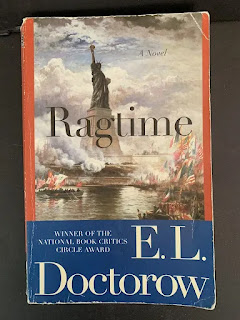Fifty years this summer, E.L. Doctorow’s turn-of-the-century historical novel Ragtime was published.
An interwoven narrative revolving around a WASP family, a black pianist and an Eastern European immigrant, their lives, like organisms seen under a microscope, collide and intersect each other, along with those of some of the era’s most famous and notorious, including Harry Houdini, J.P. Morgan, Sigmund Freud, Emma Goldman, Evelyn Nesbit and Booker T. Washington.
Ragtime occurs during America’s
Gilded Age (aka The Progressive Era), years of economic growth,
industrialization and technologic advances as the country transitioned from an
agrarian society.
With its selective view of history and zero sense of
irony, the current White House has expressed romantic admiration for the era
because of its tariff acts, ignoring the tremendous influence the rich held over
politicians who helped boost their financial empires, while the gap between the
haves and have-nots grew wider and violent: armed militias were called in to
bust heads when workers – mostly immigrants – held work stoppages or tried
forming unions. Casual racism was universal.
Coming as it did in 1975, Ragtime was part of the
run-up to the nation’s 1976 bicentennial celebration, an affirmation of two
centuries of opportunities and anxieties. Burning through the book are lit
fuses timed to explode over the coming years: feminism, celebrity culture,
domestic terrorism, mental health issues, the rise of the munitions industry,
mistrust of immigrants.
Ragtime also acknowledged that
what lies at the heart of the American Dream is the spirit of DEI: acceptance
and opportunity. An artistic immigrant lifts himself and his daughter from an airless
ghetto hovel to a career making movies. Only a few decades after the end of
slavery, the black musician makes a good enough living playing ragtime piano to
afford a new automobile. A young man who today would be considered on the
spectrum designs advanced war weaponry.
The family in Ragtime made its fortune in the
fireworks business. As we near next year’s 250th anniversary
celebration, fireworks displays will likely burst over every corner of
America’s skies. Expect them to illuminate only what we want to remember, while
keeping what we’ve chosen to forget in the dark.

No comments:
Post a Comment